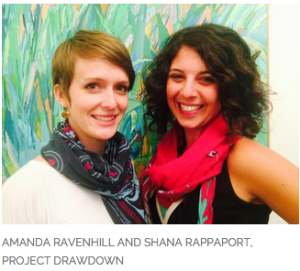Can climate change be a good thing? Shana Rappaport and Amanda Ravenhill of Project Drawdown look at climate change not as a dreaded certainty but as an opportunity for growth and change. Amanda Ravenhill is the Executive Director of Project Drawdown, which she co-founded with Paul Hawken, and Shana Rappaport is a Board Member and Strategic Adviser for the project. Today we’re discussing the role of agriculture in climate change, and how switching to a new model of agriculture can make a dramatic impact. Want to explore this issue further? After reading these excerpts of our conversation, listen to the entire interview on Inflection Point, interviews with women changing the status quo.
Lauren Schiller: So much of the argument against addressing climate change is basically either that it’s not real, or that it’s inevitable, or that it’s bad for business, how does Drawdown create a different vision?
Amanda Ravenhill: Drawdown is all about reframing the climate conversation. Right now a lot of the conversation is about stabilizing at 2 degrees or a 450 parts per million world, and we see this as a chaotic world not as a goal that people actually want to strive for.
Looking at Drawdown and looking at all of the solutions that we have in front of us, not only decarbonizing our energy infrastructure but also re-carbonizing our soils, and going through a revolution essentially in agriculture with regenerative ag, we can see Drawdown probably within the lifetime of people who are alive today.
Lauren Schiller: What are some examples of the technologies that you’re discovering?
Shana Rappaport: There are three buckets of solutions that we’re exploring. One has to do with where our energy is coming from and this inevitable transition to cleaner sources. One has to do with efficiency and optimization of the way that we use our resources, whether it’s energy or the full spectrum of natural resources. The third scope of solutions that we’re looking at are ones that actually sequester that carbon out of the atmosphere and put it back into the Earth. That is a game changer and one of the things that for me is most exciting. Rotational grazing is one of the most impactful in that realm. It’s a simple shift in the way that we practice agriculture and can have huge impacts.
Lauren Schiller: Taking agriculture as the example, what is done now?
Amanda Ravenhill: The conventional agriculture model sees dirt or soil as kind of this inert medium. It’s a very linear way of thinking. This way of thinking has gotten us into this mess in a lot of different fields, but in agriculture you basically kill the dirt through herbicides and pesticides and all these poisons that you’ve engineered the plants to be resistant to. But we’re losing all of that carbon, all those fungal networks, all the nematodes and interesting little animals that live in the soil that make it this incredible orgy of life.
Regenerative agriculture very much appreciates that biodiversity of soil and with that you get more nutritious food. You get better water retention. You have to use less fertilizer. You see the benefits are not just in bringing soil carbon levels up, the cascading benefits just keep on coming.
Lauren Schiller: The water question, of course comes top of mind. Is the California drought part of climate change? It’s so interesting to think that the way that someone approaches their agricultural management could make a difference in how much water is retained in the crops and could impact how much water they actually have to use.
Shana Rappaport: Definitely, it’s hard to attribute the drought precisely to climate change, but we can see that it’s more likely to happen with the kind of climate change we’re seeing.
My husband calls me the Queen of Silver Linings, I’m always looking for the optimistic view of things, but I think because of this drought so many more people are focusing on agriculture right now and having this really interesting conversation about water, and almonds, and pistachios, and alfalfa, and beef. I think it’s an opportunity for us to reimagine what agriculture can be in California and look at these regenerative practices: rotational grazing and composting and biochar. These different ways of really putting the soil first instead of crop fertility first.
Lauren Schiller: Rotational grazing, can you define what that is?
Shana Rappaport: People also call it intensive grazing or adaptive management. You essentially herd your cattle or sheep or any other kind of ruminant animal in a tight formation. It’s mimicking the way that these animals co-evolved with prey around them. Keep moving and keep them in a tight place. A lot of the grasslands and the prairies in the center of this country and in many other countries co-evolved with animals living on them and the soil carbon is actually built by these animals going around in small groups. They aggravate the soil and they munch on the grass and they inspire growth and move in that soil carbon and keep that system alive.
Lauren Schiller: This isn’t just theoretical, there are places where this is actually happening right now?
Shana Rappaport: There is, I think tens of thousands of farms around the world are practicing this. A man named Peter Bick who has been really instrumental and an incredible voice on carbon and soil, has a short 12 minute video called “Soil Carbon Cowboys,” that actually tells the stories of farmers in the Midwest, and the extraordinary transformations that have happened on their land in a very short period of time as a result of instituting these practices.
Learn more about Project Drawdown when you listen to the entire interview on Inflection Point.



 Noble Profit™ is an authentic source for discovering innovation, trends and investment in clean tech, and sustainable business.
Noble Profit™ is an authentic source for discovering innovation, trends and investment in clean tech, and sustainable business.